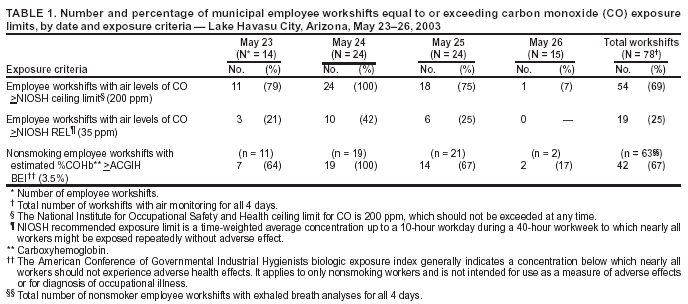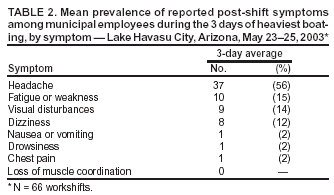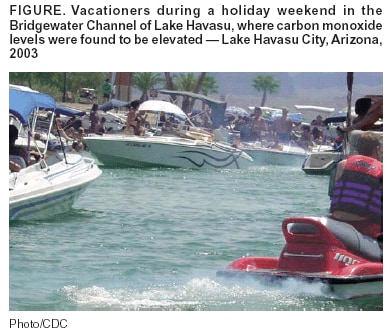 |
|
|
|
|
|
|
| ||||||||||
|
|
|
|
|
|
|
||||
| ||||||||||
|
|
|
|
|
Persons using assistive technology might not be able to fully access information in this file. For assistance, please send e-mail to: mmwrq@cdc.gov. Type 508 Accommodation and the title of the report in the subject line of e-mail. Carbon Monoxide Poisonings Resulting from Open Air Exposures to Operating Motorboats --- Lake Havasu City, Arizona, 2003During February 1997--August 2002, two fatal and six nonfatal cases of carbon monoxide (CO) poisoning occurred in vacationers who were wading in or boating near the Bridgewater Channel of Lake Havasu (Lake Havasu City [LHC], Arizona) (1). The vacationers were near operating motorboats, primarily in the channel area, where large numbers of boaters congregate during holiday weekends (Figure). One person had a carboxyhemoglobin (%COHb) level of 40% on autopsy. To evaluate CO exposure among municipal employees working in the channel, CDC and the Havasu Regional Medical Center Emergency Department (HRMCED) conducted an initial investigation during Labor Day weekend 2002 (August 31--September 1). CO concentrations in channel air exceeded all short-term exposure criteria*; four of 12 patients reporting to HRMCED because of boating-related activities had %COHb levels of >9%†. In May 2003, LHC requested assistance from CDC, the Mohave County Department of Public Health (MCDPH), the Arizona Department of Health Services (ADHS), and a private consulting firm to assess CO exposures in the channel during Memorial Day weekend 2003 (May 23--26). Follow-up environmental surveys were conducted during June--September 2003. This report summarizes the findings of these surveys, which documented excessive CO exposure and confirmed the health risk among vacationers and employees working in the channel near crowded motorboat gatherings. Community leaders and safety officials should 1) be aware that employees and vacationers in close proximity to operating motorboats can be exposed to potentially lethal levels of CO, 2) evaluate exposures, and 3) take steps to prevent poisonings. Exposure MonitoringDuring May 23--26, 2003, CDC and MCDPH conducted workshift CO-exposure monitoring and exhaled breath CO analyses among municipal employees and administered questionnaires to determine prevalence of CO-related symptoms. Exhaled breath CO concentrations (measured as parts per million [ppm] by direct-reading instruments) were measured in the morning and evening to determine changes during the day. Concentrations were then converted to estimated %COHb by using the American Conference of Governmental Industrial Hygienists (ACGIH) calculation (2). During May 24--25, ADHS investigators measured exhaled breath CO concentrations by using comparable instruments and administered brief questionnaires to a convenience sample of 62 vacationers in the channel. Vacationers' CO concentrations were measured once and converted to an estimated %COHb by using a breath analysis conversion chart. Of 40 LHC employees, 36 (90%) participated during one or more workshifts, accounting for 78 monitored workshifts. Of these workshifts, 19 (25%) involved CO exposures equal to or exceeding the NIOSH recommended exposure limit (REL)§; 54 (69%) involved short-term CO exposures that exceeded the NIOSH ceiling limit (Table 1). Of 63 workshifts involving nonsmoking employees, 42 (67%) had estimated post-shift %COHb levels that equalled or exceeded the ACGIH biologic exposure index of 3.5%¶. CO exposures decreased on the last day of the holiday weekend, when many of the boaters left the channel. During the 66 workshifts of the 3 days of heaviest boating (May 23--25), the post-shift symptoms reported most frequently by employees were headache, fatigue or weakness, visual disturbances, and dizziness (Table 2). The average estimated %COHb among nonsmoking employees increased during the day, from 1% in the morning to 6% in the afternoon. Among smokers, the average increase was from 3% to 7%. The maximum estimated %COHb level among employees was 13% in nonsmokers and 11% in smokers. Among 46 nonsmoking vacationers, the estimated %COHb increased from a mean of 1% in the morning to 11% in the afternoon. Among 16 smoking vacationers, the average estimated %COHb increased from 3% in the early afternoon to 13% in the late afternoon. The maximum estimated %COHb level among vacationers was 23% for nonsmokers and 26% for smokers**. Since the initial investigation in September 2002 (Labor Day weekend), one fatal and four nonfatal, hospital-treated CO poisonings involving loss of consciousness have occurred among channel vacationers, with %COHb levels ranging from 19% to 47% (P. Mead, MCDPH, and M. Ward, D.O., HRMCED, personal communications, 2003). One poisoning occurred on the back of a boat; the other four (including the fatality) occurred while persons were wading near boats in the channel. Ambient Air MonitoringDuring June 26--September 9, 2003, meteorologic conditions and CO concentrations were measured at fixed locations on the banks of the channel, on police and fire boats operating in and near the channel, and on police four-wheel, all-terrain vehicles patrolling the east and west banks of the channel. Concentrations in the channel and nearby onshore were higher (maximum 8-hour averages of 20--40 ppm at a typical onshore site) on the holiday weekends, when many boats were in the channel. Concentrations were highest when wind speeds were lower (<1.5 meters per second [<3.4 miles per hour]) and temperatures were higher (>90º F [>32º C]). Concentrations declined considerably with distance from the channel (e.g., maximum 8-hour averages of <1 ppm were measured at a busy intersection 350 meters from the channel). The highest CO concentrations occurred in the late afternoon and early evening, usually during 5--9 p.m., when wind speeds typically decreased. Reported by: P Roberts, PhD, Sonoma Technology, Inc., Petaluma, California. M Ward, DO, Havasu Regional Medical Center Emergency Dept, Lake Havasu City; RL Baron, MD, Banner Good Samaritan Regional Medical Center Emergency Dept, Phoenix; W Humble, MPH, M Hadzihasanovic, MD, R Cox, Office of Environmental Health, Arizona Dept of Health Svcs. L Tapp, MD, J McCammon, MS, R McCleery, MSPH, Div of Surveillance, Hazard Evaluations, and Field Studies, National Institute for Occupational Safety and Health, CDC. Editorial Note:The surveys described in this report document excessive CO exposures in employees and excessive and fatal CO exposures in vacationers amid large numbers of boats. The surveys also document substantial CO exposures in the late afternoon during crowded boating conditions, mirrored by elevations in expired CO concentrations among employees and vacationers. The majority of LHC employees had estimated %COHb levels indicating the potential for adverse health effects. Vacationers tested had higher %COHb levels than employees. These results indicate that elevated %COHb levels can occur among persons in open, outdoor settings. Previously described outdoor boat-related poisonings involved dangers to occupants of individual boats (e.g., houseboats and ski-boats) (4,5). The findings in this report are subject to at least three limitations. First, evaluation of CO-related symptoms was limited by a lack of participant information on dehydration, heat stress, physical and mental stress, and vacationer alcohol use. Many symptoms of CO overexposure (e.g., headache, fatigue, and dizziness) are associated commonly with these factors. Second, estimates of %COHb††, rather than direct measurements (blood analysis), were used to provide indications of %COHb levels. Finally, the convenience sampling method used for vacationers did not provide data to estimate the number of vacationers with increased CO levels. During the 2003 Memorial Day weekend evaluations, employees with an estimated %COHb of >5% were advised to exchange jobs with a co-worker assigned away from the channel area; those with >10% were required to remove themselves from the area immediately and, if symptomatic, advised to seek medical attention. Protective measures recommended for workers also should be recommended for vacationers until measures to reduce ambient CO exposures in the channel are implemented (6). Exhaled breath measurements should be used to screen vacationers located in areas with high ambient CO during days of heavy boat use in the channel (particularly during calm wind conditions) (7,8). Persons in communities with lakes and rivers where boats congregate in large numbers should be aware of the dangers of open air, boat-related CO poisoning and the need to evaluate CO exposures during high-traffic periods. Boat manufacturers should improve emission controls to reduce consumer CO exposure. The risk for boat-related CO poisonings should be reduced by considering measures such as limiting the number of boats in certain areas; enforcing a "no idle" policy when boats are stationary; and warning vacationers of 1) the signs and symptoms of CO poisoning; 2) the hazards related to occupying the back of the boat any time the motor is running; and 3) the risk for CO poisoning in areas of boat congestion, especially during calm weather conditions. †† An exhaled CO concentration (in ppm) is converted to an estimated level of %COHb by either a calculation or conversion chart. Estimates of %COHb were derived from the ACGIH formula for employee participants and from a conversion chart for vacationers. References
*The National Institute for Occupational Safety and Health (NIOSH) ceiling limit for CO exposure is 200 parts per million (ppm), which should not be exceeded at any time. The American Conference of Governmental Industrial Hygienists (ACGIH) excursion limit for CO is 125 ppm (or five times the threshold limit value time-weighted average [TLV-TWA]), which should not be exceeded under any circumstances. The Environmental Protection Agency National Ambient Air Quality Standard for 1-hour CO exposure is 35 ppm. †The World Health Organization recommends that %COHb levels should not exceed 2.5% in general population. ACGIH recommends a worker biologic an exposure index (BEI) for CO of 20 ppm in end-of-shift exhaled breath or an estimated %COHb level of 3.5%. § TWA concentration up to a 10-hour workday during a 40-hour workweek to which nearly all workers might be exposed repeatedly without adverse effect. ¶ ACGIH BEI generally indicates a concentration below which nearly all workers should not experience adverse health effects (not intended for use as a measure of adverse effects or for diagnosis of occupational illness). ** In persons with no occupational exposure to CO, nonsmokers have an average %COHb level of 0.9% (range: <0.5%--2.1%); smokers average 4.3% (range: <1.0%--8.7%) (3). †† An exhaled CO concentration (in ppm) is converted to an estimated level of %COHb by either a calculation or conversion chart. Estimates of %COHb were derived from the ACGIH formula for employee participants and from a conversion chart for vacationers.
Table 1  Return to top. Table 2  Return to top. Figure  Return to top.
Disclaimer All MMWR HTML versions of articles are electronic conversions from ASCII text into HTML. This conversion may have resulted in character translation or format errors in the HTML version. Users should not rely on this HTML document, but are referred to the electronic PDF version and/or the original MMWR paper copy for the official text, figures, and tables. An original paper copy of this issue can be obtained from the Superintendent of Documents, U.S. Government Printing Office (GPO), Washington, DC 20402-9371; telephone: (202) 512-1800. Contact GPO for current prices. **Questions or messages regarding errors in formatting should be addressed to mmwrq@cdc.gov.Page converted: 4/22/2004 |
|||||||||
This page last reviewed 4/22/2004
|